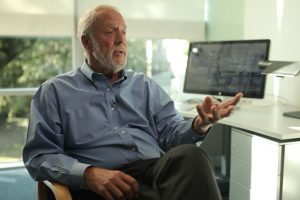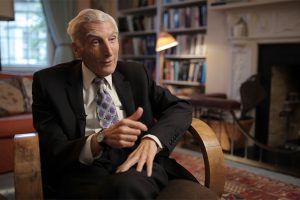Behavioral Genetics
Behavioral geneticist Robert Plomin on twin studies, genetic influence of parents on their children, and 1% of...
Is cancer a genetic disease? Which genes may contribute to cancer? How can this knowledge lead to the development of new drugs? These and other questions are answered by Professor of Cancer Medicine and Oncology in the Imperial College London, Justin Stebbing.
I’m going to talk about cancer-causing genes, because cancers are genetic disease. But it’s really important to understand what I mean by that, because having genes within us that lead to the development of cancer is actually quite rare. If I go weightlifting I become big and strong — obviously I weight lift every day, you can tell! But in all seriousness, I might get very muscly but I don’t pass those genes down to my children. I pass down my eye color, my hair color (or what’s left of it) to my children.
When I talk about cancer being a genetic disease what I’m willing to say is new genes that aren’t part of me, a bit like the muscles that develop when I weight lift. I don’t pass those genes to my children.
So we know cancer is a genetic disease because it contains cells without normal genes in them, cells with mutated genes, fused genes, different copy numbers of genes, different components of genes.
But genes within us that contribute to a family history of cancer are, once again, thankfully rare. We’ve all heard of BRCA1 and BRCA2: that contributes to about maybe 5% of breast cancers, maybe slightly more ovarian cancers, such that we now screen all women with ovarian cancer for BRCA genes and the vast majority of young women or women with a family history of breast cancer BRCA genes as well.
We know, for example, that if our own cells (and it would be every cell in our bodies) contain mutated BRCA1 or BRCA2 genes the lifetime incidence of breast or ovarian cancer is really high: higher with BRCA1 then with BRCA2 but we recommend often bilateral mastectomies and removal of ovaries. If people with those genes get cancer we can actually target the cancers using what we call synthetically lethal medicines targeting those genes. We call those PARP inhibitors and there’s several of those around. We’re looking, for example, with a ‘100,000 genomes’ project in England and other genomic analyses for other genes that contribute to a family history of cancers. We know mutated BRCA genes are important in other tumors as well: they’re important in pancreatic cancer, not just a breast and ovarian cancer, and they’re probably important in other diseases such as prostate cancer as well.
We’re finding other genes that contribute, such as CHEK1 or NBN which don’t lead to a massive lifetime risk of developing these cancers but as we’re learning more we’re understanding how to use this genetic information in the day-to-day management of patients affected by cancer. When we think of cancer and we think of the causes there’s a massive unknown box but sometimes we know that people have genes within their bodies, within their normal cells that lead to those normal cells becoming cancerous. We have ways of preventing that, for example, with surgery or even specific drugs. For example, Angelina Jolie has a BRCA gene so she had a bilateral mastectomy and had an oophorectomy. It changes her lifetime incidence of developing breast or ovarian cancer from, say, 95% or 80% to close to 0% for both. You can never fully get it down to zero because even doing a mastectomy you leave some breast cells behind but that’s one approach to changing the lifetime risk of a disease developing from nearly 100% to nearly 0%. That’s a massive difference.
Sometimes we can use breast cancer preventive therapies and there are other ways for other tumors as well. We can put people into screening programs with imaging and radiologic detection and really do so much better now than we’ve ever been able to do in the past. If people develop cancers we have ways of treating that, again, with surgery, radiotherapy and specific drugs. We have ways of monitoring these patients as well, so if they are going to detect cancer we can detect it earlier and that’s not just scans but blood tests as well and physical examinations. It’s about understanding how to incorporate these tests into our everyday life to remove the stigma so people can live with this information and lead long and happy lives and not die rapidly from it and think it’s the end of the world.
The use of immunotherapy is based on our understanding of a gene called PD-1 and PD-L1 or another gene called CTLA4. Specific drugs and clinical trials and drugs used every day are based on mutations in the EGFR gene or fusions in the OUT gene and there’s a gene called BCR which when fused with the gene called ABL in chronic myeloid leukemia has led to the development of a drug called imatinib such that people with chronic myeloid leukemia now can expect to have a normal life expectancy. We treat breast cancer based on the occurrence of genes such as the estrogen receptors, progesterone receptors and HER2. If people have breast cancers with increased levels of the HER2 gene on chromosome 17 we give drugs such as Herceptin, or Trastuzumab, or Kadcyla, or other genes if the disease progresses. By understanding these genes we can understand what turns cancer cells on; if we understand what turns cancer cells on we can work out how to turn them off.
So we treat everyone’s tumors differently, we personalize patients treatments treating the right person with the right cancer with the right medicines at the right time.
By treating people personally we maximize the chances of our medicines and our approaches working and we minimize side-effects and toxicity.
By doing that and by understanding cancer genes and understanding host genes that contribute to cancer what we’re hopefully doing is increasing the cure rate and even if we can’t increase the cure rate we’re turning cancer into a chronic disease like in chronic myeloid leukemia that people live with as opposed to dying from it.
My laboratory at Imperial College specializes in what we call gene regulation. We’ve got 3 billion letters of DNA that exists in our brain cells, in our mouth cells in our lung cells, in our breast cells. What determines if a cell becomes a breast cell, or a breast cancer cell, or a breast cancer stem cell that can remain dormant for many years? We populate the a breast stem cells. It’s the way those 3 billion letters have turned on and off and we call that gene regulation. By understanding that better we can really improve the lives of patients living with cancer, increase the rate of early diagnosis and therefore increase the cure rate by understanding the genes of cancer which we can now measure from a simple blood test, not just by performing an invasive biopsy. We call that analysis of cell free DNA which is something that we’re studying as well at Imperial College. Things are moving at supersonic speed here so we can really understand how cancer genes have changed, how they change over time and how we can target them better.

Behavioral geneticist Robert Plomin on twin studies, genetic influence of parents on their children, and 1% of...

Neuroscientist Karl Friston on the Markov blanket, Bayesian model evidence, and different global brain theorie...

Physicist Martin Rees on Isaac Newton, theory of general relativity, and black holes